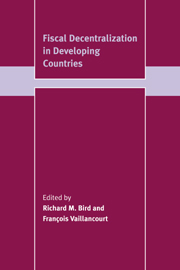Book contents
- Frontmatter
- Contents
- List of tables
- List of contributors
- Preface
- 1 Fiscal decentralization in developing countries: an overview
- 2 China: evaluating the impact of intergovernmental fiscal reform
- 3 India: intergovernmental fiscal relations in a planned economy
- 4 Indonesia and Pakistan: fiscal decentralization – an elusive goal?
- 5 Morocco and Tunisia: financing local governments – the impact on infrastructure finance
- 6 Colombia: the central role of the central government in fiscal decentralization
- 7 Argentina: fiscal federalism and decentralization
- 8 South Africa: an intergovernmental fiscal system in transition
- 9 Bosnia-Herzegovina: fiscal federalism – the Dayton challenge
- Index
3 - India: intergovernmental fiscal relations in a planned economy
Published online by Cambridge University Press: 09 October 2009
- Frontmatter
- Contents
- List of tables
- List of contributors
- Preface
- 1 Fiscal decentralization in developing countries: an overview
- 2 China: evaluating the impact of intergovernmental fiscal reform
- 3 India: intergovernmental fiscal relations in a planned economy
- 4 Indonesia and Pakistan: fiscal decentralization – an elusive goal?
- 5 Morocco and Tunisia: financing local governments – the impact on infrastructure finance
- 6 Colombia: the central role of the central government in fiscal decentralization
- 7 Argentina: fiscal federalism and decentralization
- 8 South Africa: an intergovernmental fiscal system in transition
- 9 Bosnia-Herzegovina: fiscal federalism – the Dayton challenge
- Index
Summary
There has been a resurgence of interest in fiscal decentralization in virtually every part of the world in the last three decades. Interest has not merely been confined to constitutionally declared federations but has also been seen in unitary countries; it spans both the ideological spectrum and levels of development across countries. While the emergence of the European Union as an economic entity has underlined the advantages of having an enlarged common market with a distinct regional identity, the economic collapse of the former Soviet Union has demonstrated the dangers of economic and administrative centralization. In general, administrative and fiscal decentralization has been prompted by the emphasis placed on providing efficient and responsive public services. However, fiscal decentralization has often been warranted by market decentralization arising from economic liberalization. In India too, in keeping with the general trend, decentralization has been a much debated issue.
India represents a classic case of a federation with constitutional demarcation of functions and finances between the center and the states. The 920 million people in the federation are spread over twenty-five states and seven centrally administered territories (two with their own elected governments). Separate legislative, executive, and judicial arms of government are constituted at both central and state levels. The upper house, or Rajya Sabha, in the federal parliament is the House of States, to which members are elected by an electoral college from each of the states.
- Type
- Chapter
- Information
- Fiscal Decentralization in Developing Countries , pp. 78 - 114Publisher: Cambridge University PressPrint publication year: 1999
- 3
- Cited by



